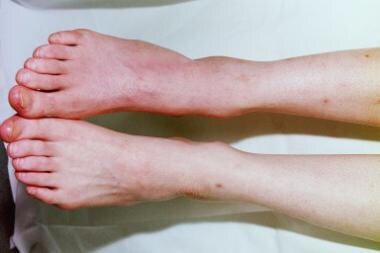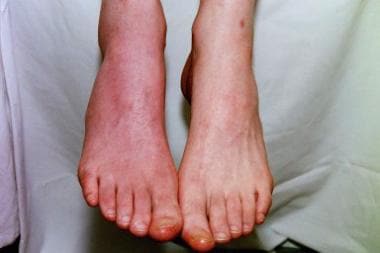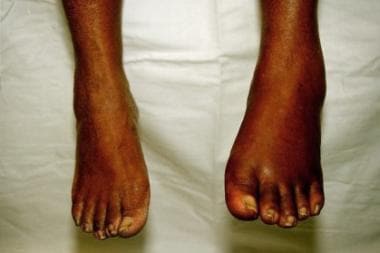Background
Complex regional pain syndrome (CRPS) may develop as a disproportionate consequence of a trauma affecting the limbs without nerve injury (CRPS I, or reflex sympathetic dystrophy [RSD]) or with obvious nerve lesions (CRPS II, or causalgia). (See images below and Images 1-4.)
A 29-year-old woman with reflex sympathetic dystrophy in the right foot demonstrates discoloration of the skin and marked allodynia.
This photo shows the same patient as in the above image, following a right lumbar sympathetic block. Marked increase in the temperature of the right foot is noted, with more than 50% pain relief.
A 68-year-old woman with complex regional pain syndrome type II (causalgia).
A 36-year-old woman with right arm reflex sympathetic dystrophy and dystonic posture (movement disorder).
See the list below:
In the 17th Century, Ambroise Pare presented the earliest description of RSD as severe burning pain following peripheral nerve injury. Pare, a surgeon, treated King Charles IX for smallpox by inducing bleeding with a lancet applied to the arm. After this treatment, the king suffered from persistent pain, muscle contracture, and inability to flex or extend his arm.
In 1864, Mitchell coined the term causalgia, which means burning pain, to describe persistent symptoms following gunshot wounds to peripheral nerves during the American Civil War.
In 1900, Sudeck described radiographic spotty osteopenia.
In 1916, Leriche focused on the sympathetic nervous system.
In 1943, Livingston expanded the Leriche vicious circle theory that includes the following:
Abnormally firing, self-sustaining loops in the dorsal horn
Provoked by a small irritation focus in small nerve endings of major nerve trunks
Activating central projecting fibers, giving rise to pain
In 1946, Evans used the term RSD, believing that sympathetic hyperactivity is involved somehow in the abnormal activity in the periphery.
In 1993, the International Association for the Study of Pain (IASP) held a Special Consensus Conference addressing diagnosis and terminology (endorsing the term CRPS).
In 1995, Paice wrote that, even after 130 years, there was still no general agreement on what to call RSD, what causes it, or how best to treat it.




